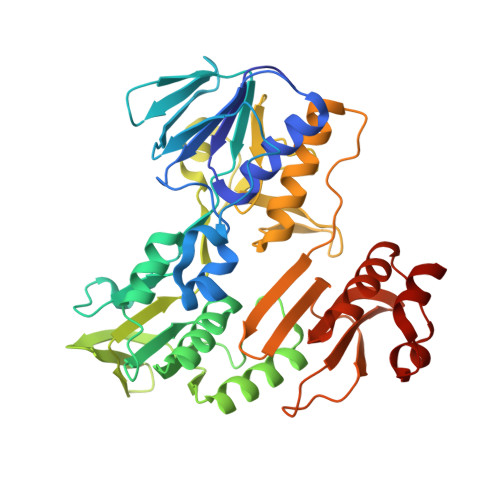Molecular Mechanism of the Redox-dependent Interaction between NADH-dependent Ferredoxin Reductase and Rieske-type [2Fe-2S] Ferredoxin
Senda, M., Kishigami, S., Kimura, S., Fukuda, M., Ishida, T., Senda, T.(2007) J Mol Biol 373: 382-400
- PubMed: 17850818
- DOI: https://doi.org/10.1016/j.jmb.2007.08.002
- Primary Citation of Related Structures:
2E4P, 2E4Q, 2GQW, 2GR0, 2YVF, 2YVG, 2YVJ - PubMed Abstract:
The electron transfer system of the biphenyl dioxygenase BphA, which is derived from Acidovorax sp. (formally Pseudomonas sp.) strain KKS102, is composed of an FAD-containing NADH-ferredoxin reductase (BphA4) and a Rieske-type [2Fe-2S] ferredoxin (BphA3). Biochemical studies have suggested that the whole electron transfer process from NADH to BphA3 comprises three consecutive elementary electron-transfer reactions, in which BphA3 and BphA4 interact transiently in a redox-dependent manner. Initially, BphA4 receives two electrons from NADH. The reduced BphA4 then delivers one electron each to the [2Fe-2S] cluster of the two BphA3 molecules through redox-dependent transient interactions. The reduced BphA3 transports the electron to BphA1A2, a terminal oxygenase, to support the activation of dioxygen for biphenyl dihydroxylation. In order to elucidate the molecular mechanisms of the sequential reaction and the redox-dependent interaction between BphA3 and BphA4, we determined the crystal structures of the productive BphA3-BphA4 complex, and of free BphA3 and BphA4 in all the redox states occurring in the catalytic cycle. The crystal structures of these reaction intermediates demonstrated that each elementary electron transfer induces a series of redox-dependent conformational changes in BphA3 and BphA4, which regulate the interaction between them. In addition, the conformational changes induced by the preceding electron transfer seem to induce the next electron transfer. The interplay of electron transfer and induced conformational changes seems to be critical to the sequential electron-transfer reaction from NADH to BphA3.
Organizational Affiliation:
Japan Biological Information Research Center, Japan Biological Informatics Consortium, 2-42 Aomi, Koto-ku, Tokyo 135-0064, Japan.

















